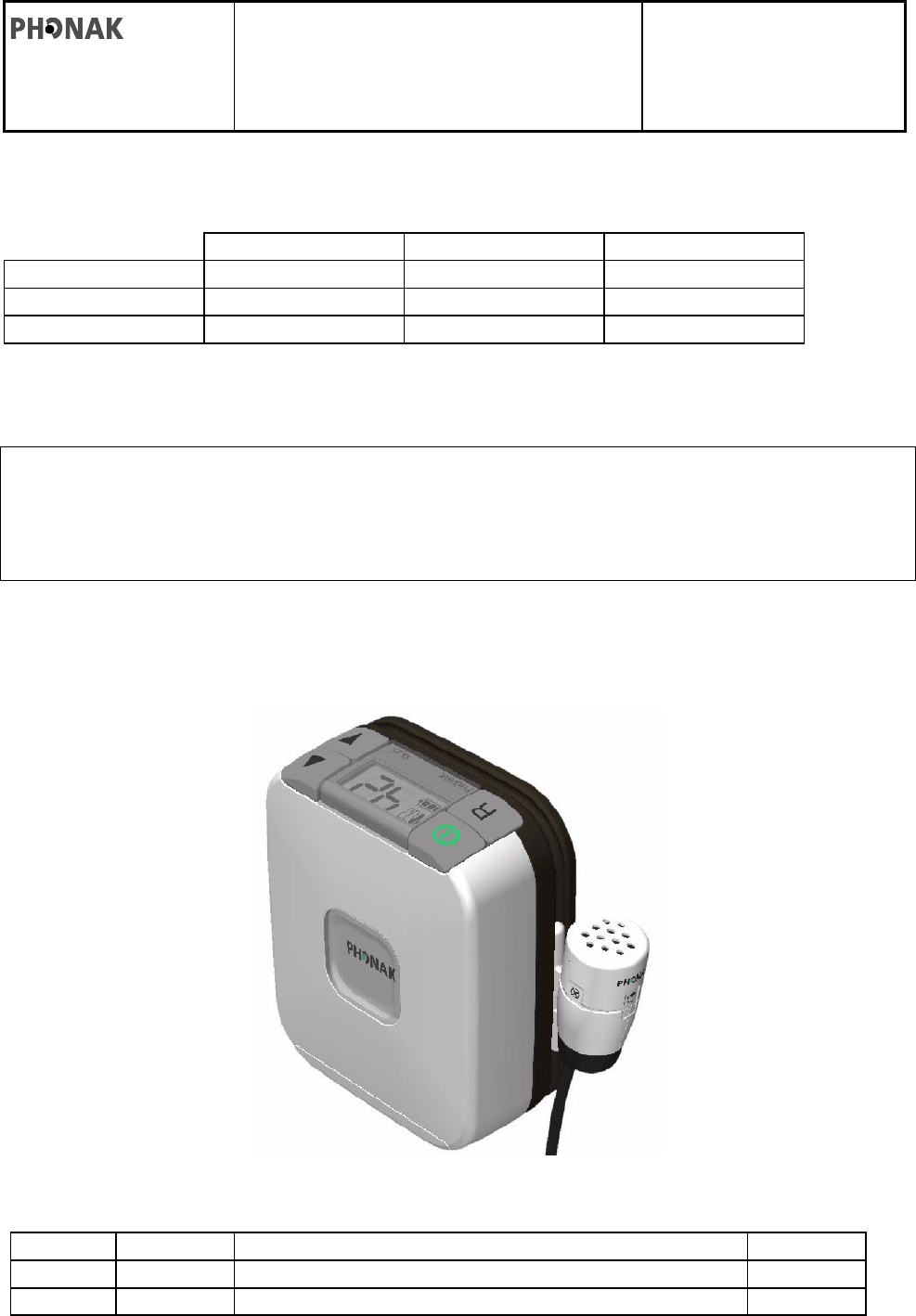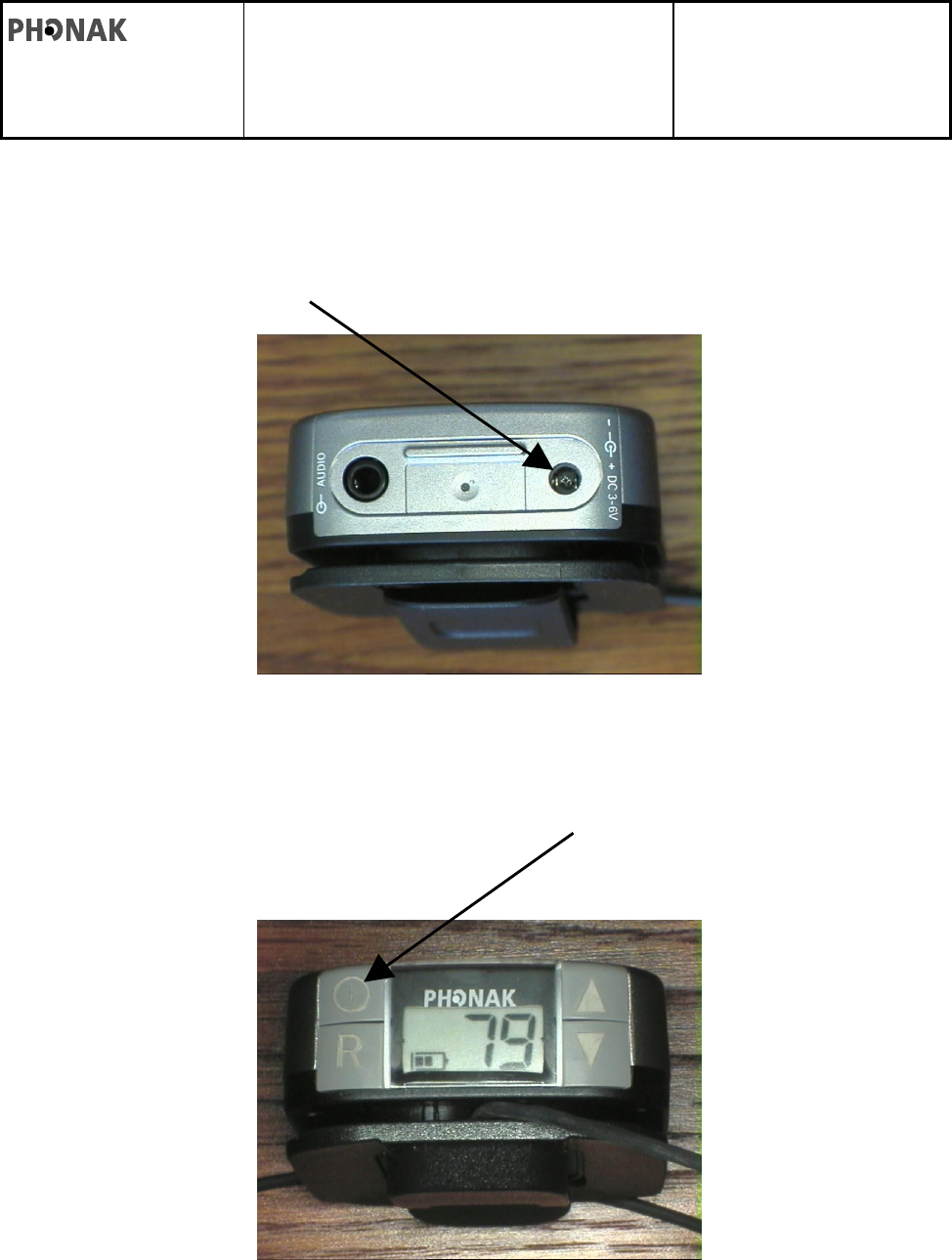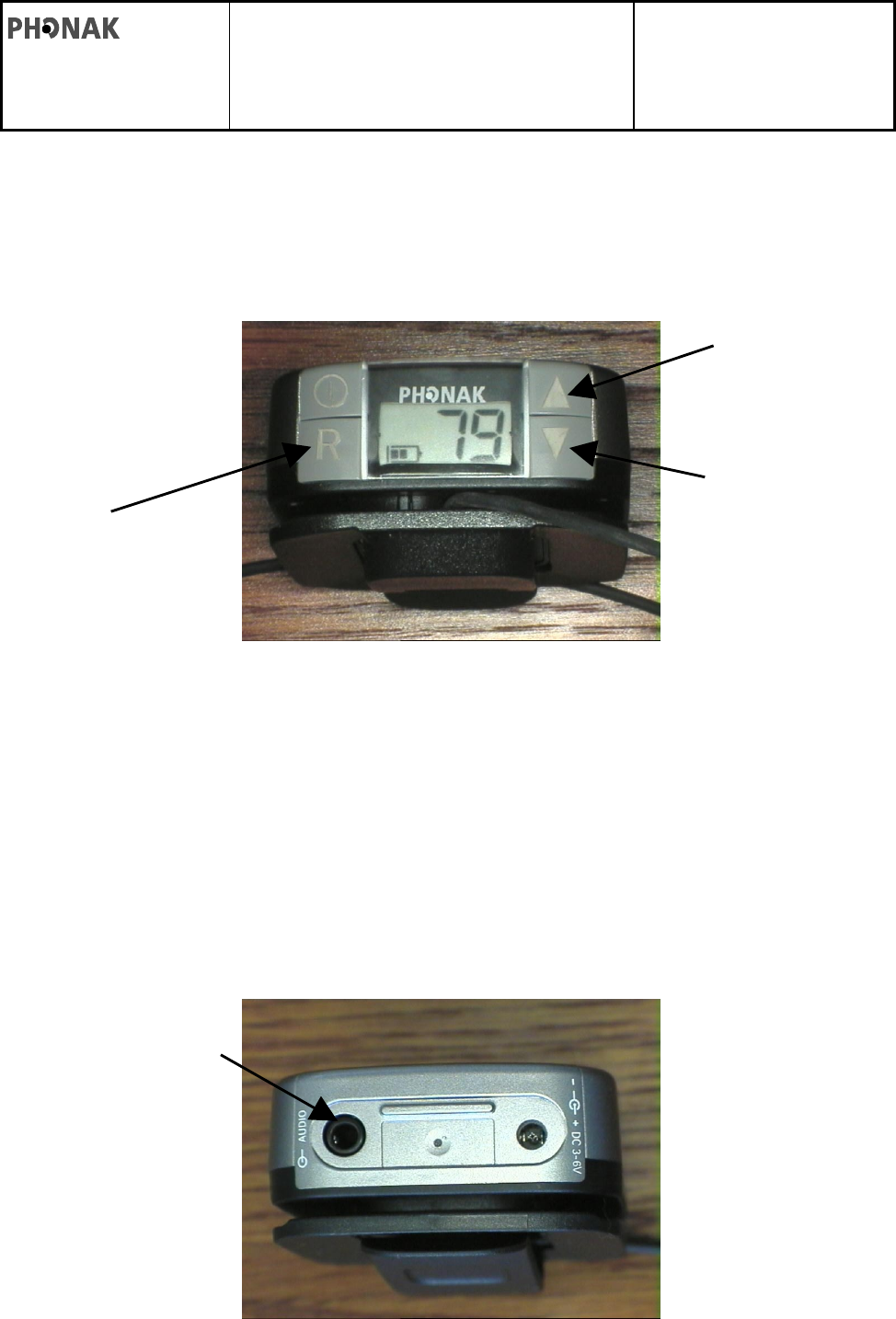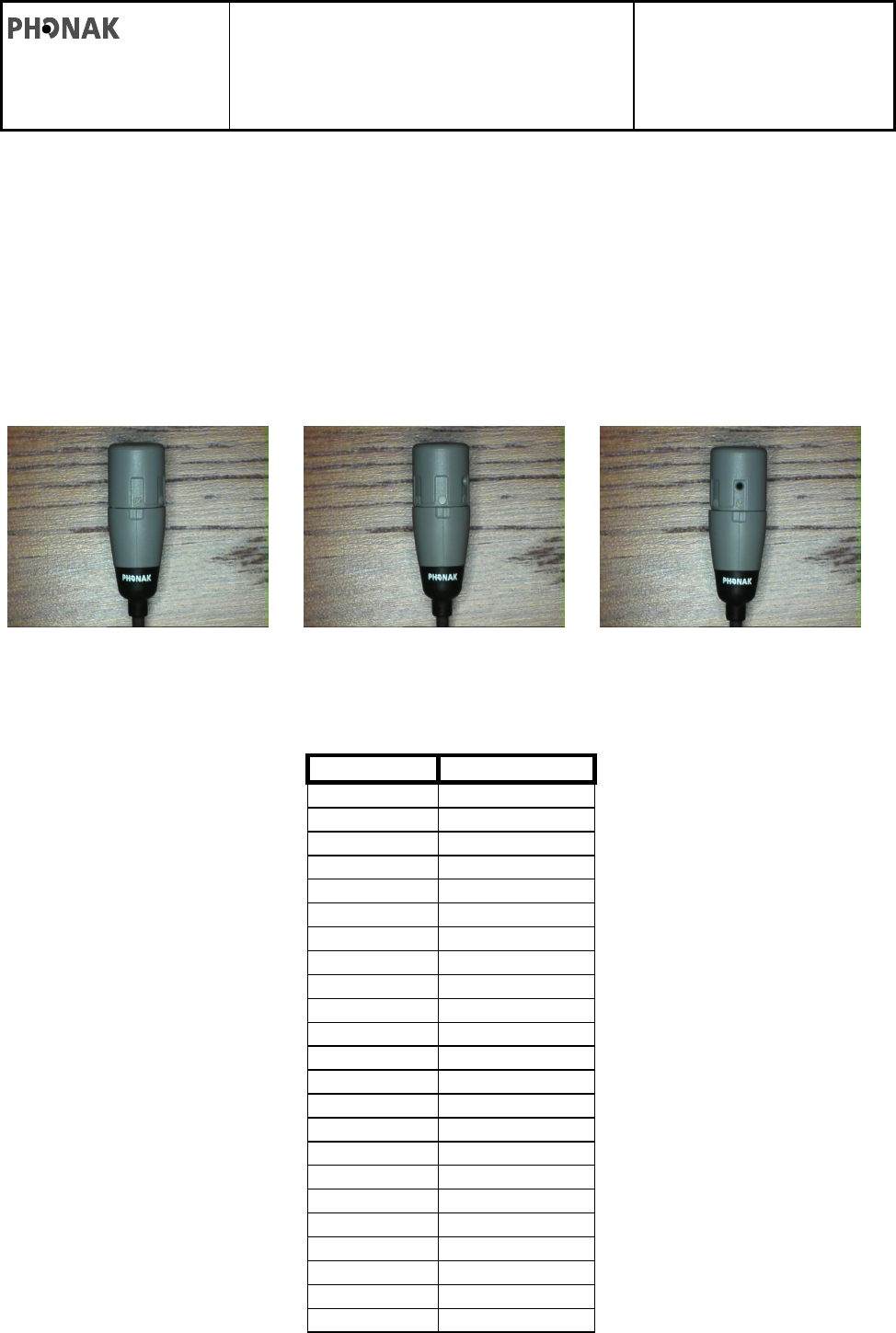Sonova USA CAMPUS User Manual Design Specification
Phonak Inc Design Specification
Manuel

communication
systems
Development
Technical Note
Manuel
Campus S FM Transmitter (TX2S)
US Version
Doc.:
Vers.:
Page:
Date:
TN010906.doc
V1
1 of 5
06.09.01
Distribution: Montena EMC SA, CH-1728 Rossens, Mr Manfred Portman
Path: Marquis:> D:/data/phonak/T_memos/Englisch/TN010906.doc
Name Date Visum
Produced by F. Marquis 06.09.01 FMa
Approved F. Marquis 06.09.01 FMa
Released F. Marquis 06.09.01 FMa
Manuel
Campus S FM Transmitter (TX2S)
History:
Version Date Modifications Pages
V1.0 06.09.01 New document all

communication
systems
Development
Technical Note
Manuel
Campus S FM Transmitter (TX2S)
US Version
Doc.:
Vers.:
Page:
Date:
TN010906.doc
V1
2 of 5
06.09.01
Background
Hearing impaired persons use hearing aids (HA), which are electroacoustic amplifiers including a microphone
and an earphone and having frequency response and dynamic characteristics specific to each hearing loss.
BTE (Behind-The-Ear) hearing aids have the possibility to be connected to an external microphone, by
means of electrical contacts placed on the bottom of the apparatus.
A wireless solution for a remote microphone still exists: an FM radio receiver is connected to the HA, via the
electrical contact system for the external microphone. This FM radio receiver can be either :
• In form of a little box, self powered by its own battery, and connected to the contact system by a
cable (for example Microvox R),
or
• A new system, fully miniaturised (Phonak Microlink), having the form of a piece of sugar, powered
by the hearing aid battery, an clipped on the bottom of the BTE-HA.
A previous FM transmitter (Microvox TX2) is still in use for application in schools. The microphone is
connected with a cable to the small transmitter having the form of a little box. The transmitter is fixed to the
clothes by a clip and the microphone by a small cord around the neck or a needle to the shirt.
The Campus S (TX2S) is a more convenient remote microphone for hearing impaired persons. Campus S
has an integrated synthesizer which allows to change the frequency of the transmitting channel.
TX2S is the development name of Campus S.
Product description
The Phonak Campus S is a FM transmitter (channel bandwidth of 25 kHz) for FM receivers, as the Phonak
MicroLink or MicroVox, connected to hearing aid instruments. Its frequency for north america is from 216 to
217MHz.
The Campus S is equipped with 2 audio inputs:
• Microphone-input for speech transmission (teacher)
• Audio-input for external audio source (CD-player, radio, ...)
The microphone can be switched as omnidirectional or directional.
The Campus S has 2 modes of operation: off and active (transmitting). The status of the Campus S is
indicated with the LCD display. When in off sate, the LCD display is blank. When transmitting, the Channel
number is indicated on the LCD display.
It can manually be switched on and off.
The Audio-input adds the left and right channels of a stereo signal to generate a mono signal.
The Campus S is powered by a prismatic NimH accumulator. A DC power supply (wallcharger) is used to
charge the accumulator. The Campus S is protected against polarity inversion and false voltage (too high or
AC).
The microphone cable is used as transmitter antenna.

communication
systems
Development
Technical Note
Manuel
Campus S FM Transmitter (TX2S)
US Version
Doc.:
Vers.:
Page:
Date:
TN010906.doc
V1
3 of 5
06.09.01
Operating description
Before starting, charge the accumulator of the Campus S during at least 12 hours. To do this, connect the
plug of the Wall-Charger to the DC input shown on figure 1. The DC input voltage must be between 3VDC
and 6 VDC.
fig. 1 Campus S, audio and DC input
1. Switching ON/OFF
To switch the Campus S ON, press during 1 second on the "ON/OFF" button. Then the channel number will
be displayed. The accumulator charge status is displayed.
The Campus S is transmitting on the displayed channel.
fig. 2 LCD and buttons
To switch the Campus S OFF, press during 1 second on the "ON/OFF" button. The LCD display will become
blank. The Campus S is in OFF state and is no more sending.

communication
systems
Development
Technical Note
Manuel
Campus S FM Transmitter (TX2S)
US Version
Doc.:
Vers.:
Page:
Date:
TN010906.doc
V1
4 of 5
06.09.01
2. Channel change
To change the transmitting channel of the Campus S, press button "channel UP" or "channel DOWN" shown
on fig. 3. Then the new channel number will be displayed and the Campus S is transmitting on the new
channel. "Channel UP" will increment to the next available channel and "channel DOWN" will decrement to
the next available channel. There are 23 channels programmed in the Campus S (see list in para 6.
fig. 3 LCD and buttons
3. Remote Control function
By pushing the "Remote Control" button, the Campus S will inductively send a command to synchronize
future receivers to the same frequency.
4. External audio source
An external audio source (CD player, Radio, ...) can be connected to the Campus S via the audio input Jack
(3.5mm). The audio level will be adapted with an AGC circuit (Automatic Gain Control). The signal will be
mixed with the signal of the MM8 microphone. The microphone can be switched OFF.
fig. 4 Campus S, audio and DC input
channel UP
channel DOWN
Remote Control
A
udio Input

communication
systems
Development
Technical Note
Manuel
Campus S FM Transmitter (TX2S)
US Version
Doc.:
Vers.:
Page:
Date:
TN010906.doc
V1
5 of 5
06.09.01
5 MM8 microphone
The MM8 microphone can be set in 3 different modes by rotation of the upper part of the microphone.
In fig. 5, the MM8 microphone is set in "OFF" position. In this case, only the external audio signal will be
transmitted.
In fig. 6, the MM8 microphone is set in "OMNI" position. In this case, the microphone has an omni-directional
characteristic
In fig. 7, the MM8 microphone is set in "DIR" position. In this case, the microphone has an directional
characteristic
fig. 5 Position "OFF" fig. 6 Position "OMNI" fig. 7 Position "DIR"
6 Frequency list of the 23 channels
Phonak Channel Frequency [MHz]
N01 216.0125
N02 216.0375
N04 216.0875
N05 216.1125
N08 216.1875
N09 216.2125
N12 216.2875
N13 216.3125
N16 216.3875
N17 216.4125
N18 216.4375
N61 216.5125
N62 216.5375
N64 216.5875
N65 216.6125
N68 216.6875
N69 216.7125
N72 216.7875
N73 216.8125
N76 216.8875
N77 216.9125
N79 216.9625
N80 216.9875